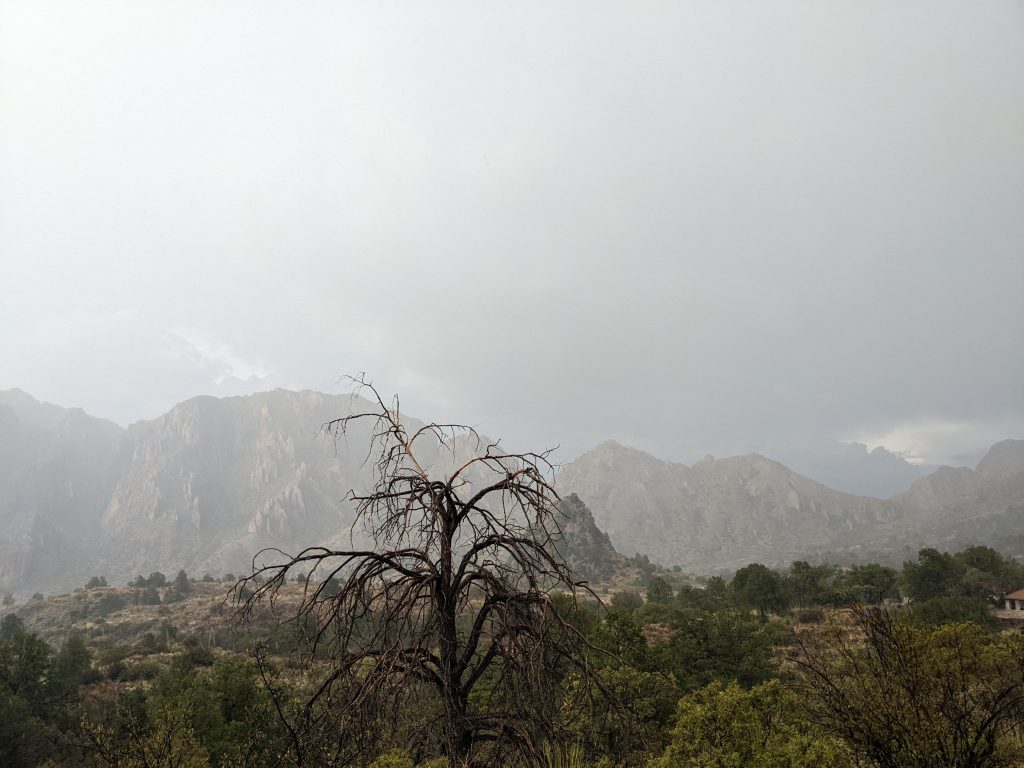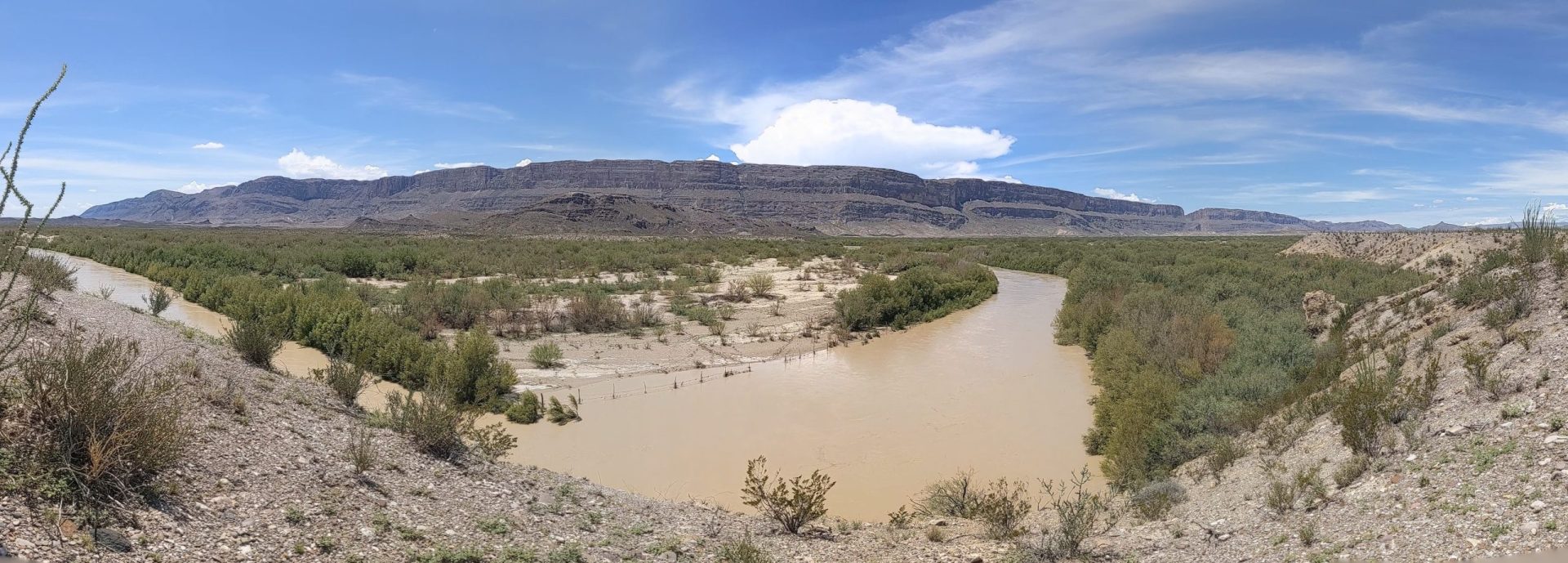Big Bend doesn’t fuck around when it comes to the weather. This park can kill you at either extreme of hot or cold. While heat related deaths are the most common fatalities in Big Bend, cold has also claimed a life or two.
The takeaway: The weather here is to be taken seriously – no matter what time of year.
This short guide will help you understand the park’s diverse climate and plan a safe and survivable trip.
Table of Contents
Average Temperature and Precipitation by Month
According to nationparked.com, these are the average temperatures and precipitation levels by month in Big Bend National Park.
| Month | Avg High | Avg Low | Record High | Record Low | Avg Precip |
|---|---|---|---|---|---|
| January | 61 | 35 | 87 | 17 | 0.56 |
| February | 66 | 38 | 96 | 20 | 0.50 |
| March | 77 | 45 | 102 | 19 | 0.36 |
| April | 81 | 52 | 109 | 28 | 0.64 |
| May | 88 | 59 | 113 | 42 | 1.36 |
| June | 94 | 66 | 114 | 60 | 1.80 |
| July | 93 | 68 | 112 | 54 | 2.43 |
| August | 91 | 66 | 109 | 61 | 2.13 |
| September | 86 | 62 | 110 | 47 | 1.49 |
| October | 79 | 53 | 104 | 27 | 1.50 |
| November | 69 | 42 | 97 | 23 | 0.57 |
| December | 62 | 36 | 90 | 10 | 0.42 |
I’m not a huge fan of this type of chart because it could be easy to think you can visit Big Bend any time of year.
The Problem With Averages
Average temperatures often don’t tell the whole story. While the park offers pleasant weather during some months, others can be scorching hot or experience unpredictable monsoon rains.
That is simply not quite true so let’s talk about some of the more nuanced things to know about this park’s weather.
First off, the temperatures on this chart are from NPS data that was collected at the Panther Junction park headquarters. Panther Junction is about 5-10 degrees cooler than the Rio Grande area. Meanwhile, the Chisos Basin tends to be about 10-20 degrees cooler than Panther Junction.
Compared to the rest of the park, the Chisos Mountains are cooler in the summer but warmer in the winter.
Deserts are weird.
Extrapolating from these numbers, that means average temperatures in the Rio Grande would be around 104 in June. With full exposure on many trails in that area, that’s a serious safety concern!
Stick to the Chisos From June through August
June through August are typically the hottest months in Big Bend. The only place that I would even consider hiking during the summer is trails in the Chisos Mountains. Even those I would approach with considerable caution.
While the worst of the heat begins in June, May-September is so hot that much of the park is actually closed. And honestly, visitors should probably just…not fucking be there.
The desert floor, especially way down South near the Rio Grande, regularly reaches 100+ degrees Fahrenheit between April and October. Most of the trails have little to no shade. Literally none.

That’s the time of year when people die from dehydration and heat stroke. And by people, I don’t just mean random, uninformed tourists (clearly not you, since you’re here). I mean experienced, lifelong hikers who at least nominally know what they’re doing.
Don’t mess with (the heat in) Texas, folks.
About the Rain in the Chisos Mountains
As I said, the only safe place to hike, temperature wise between May and September, is in the Chisos basin. However, because Mother nature likes to fuck with us May-September is also the rainy season in Big Bend.
In fact, July through August is actually monsoon season for the Chisos Mountains.

High summer in the Chisos is incredibly prone to violent thunderstorms. Keep this in mind when planning your summer soiree to the mountains.
Jon and I spent our first night ever in Big Bend thinking we were going to be struck dead by lightning. We had camped up in the Pinnacles backcountry sites and spent the whole night soaked and regretting our life choices.
We were idiots and didn’t do the proper research beforehand to know that this was monsoon season. Don’t be like Jon and Gabrielle.
The Most Popular Months to Visit Big Bend National Park
Peak visitation season in Big Bend National Park runs from October to April. This is because – duh – the temperatures generally aren’t hot enough to kill you, and the storms aren’t likely to flood your campsite or strike you dead with lightning. In other words, you can relatively safely explore the whole of the park.
Remember when I said that the Chisos is generally about 10-20 degrees cooler than the desert in summer?
In the winter, the park plays a funny little trick. Those familiar with deserts won’t be surprised but winter time desert temperatures are actually about 7 degrees cooler than what you’ll find in the Chisos.
That means that, compared to the rest of the park, the Chisos Mountains are cooler in the summer and warmer in the winter. I personally experienced this when I woke up early in the Chisos one January morning and drove over to the Rio Grande village area to hike Marufo Vega.
I stepped out of my car without a jacket, and a cold morning wind hit me like a sheet of ice! I hopped right back into the car and put on another layer. Make sure you pack for that!
Too Long: Didn’t Read;
You can check current weather conditions in Big Bend National Park on the NPS website, here.
Whenever you decide to visit Big Bend, carefully consider the weather and do some research.
Stay out of the desert if you visit between June and August. And also stay out of canyons (flash floods will also kill you). And don’t go up on the peaks during thunderstorms because: lightning. This isn’t actually that complicated, I swear!
Any time from April through October, dress in layers, plan for changing weather conditions, and pack extra water. In short, plan wisely, be careful, and pack appropriately. Be smart and you’ll have a great not too hot, not too cold trip!

